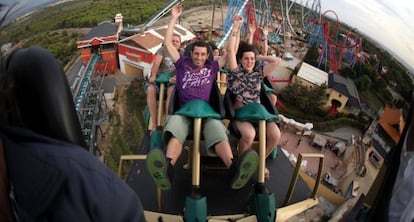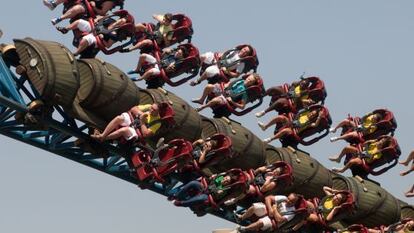Inside the adrenalin business: a guide to Spain’s top theme parks
A look at the thrills, and the prices, at Parque Warner, Terra Mítica, Isla Mágica and PortAventura


Panic in Gotham City. A bad guy has busted out of jail, and the city’s populace won’t be able to sleep safe in their beds until he’s caught: Batman to the rescue. But instead of leaping into the Batmobile, our superhero is going to use a rollercoaster that soars up to 30 meters high, twisting and turning at up to 85 kilometers an hour to catch the criminal. Only the bravest fans would dare to join the chase.
And Miguel is one of them. The 12-year-old offers our less-than-intrepid journalist some advice: “It’s not so bad. Just hang on and scream.” But his friend in the seat behind is crueler than the Joker: “When you hear the crunch, then things really speed up.” He’s not lying. A few “aaaaaaaaaggghhhhs” later, the two youngsters are ready for another go: “Get ready!”
The setting in this case is the Parque Warner theme park on the outskirts of Madrid, but is repeated throughout the summer in others: Terra Mítica, Isla Mágica, and PortAventura. Spain’s four biggest theme parks attract around six million people in the high season, drawn by the prospect of being plummeted, pummeled and propelled at high speed on rides such as the one described above. The vast majority of visitors, around four million, head to PortAventura. “I like the really bad ones,” says 25-year-old Carolina Jover as she wanders through the ancient Egypt zone at Terra Mítica in Benidorm.
Parque Warner

Located in the Madrid dormitory town of San Martín de la Vega, 20 kilometers southeast of the capital, Parque Warner opened in 2002, and is owned by the Parques Reunidos group. Around 1.2 million visitors passed through its gates in 2013, says the company.
Prices A member of Capte, Spain's theme park aficionado club, says they are "acceptable". Entry tickets for adults are €39.90, with online purchases subject to discounts. A visit to the water park costs an extra €14.90.
Overall assessment "Not much variety of shows, good theming based on movies and cartoons, offers all year round, but not much for adults," says a Capte member. The most popular rollercoaster rides are Batman: the chase, and Superman: attración de acero, while Stunt fall is considered one of the best attractions in Spain. Staff say that the Police Academy show is the best on offer at the park.
Asked why they would swap lying on a beach for being hurled upside down for 10 minutes at a time, most visitors to Spain’s theme parks say “adrenalin”. That and “the kids,” who seem to take special pleasure in taunting the actors playing ancient Romans, Spartans and Egyptians at the park.
Most parents say that a theme park is an “obligatory” visit over the course of the summer holidays, and the youngsters want to go on the scariest rides. “She doesn’t care. She wanted to go on the Jaguar, but she’s still too small,” says Rafael Arias Vega, sitting next to his daughter Rocío in a recreation of a tree trunk that is destined to receive several soakings during its journey at Seville’s Isla Mágica. Nearby, in the shade, sits 76-year-old Francisca Peña López, who can’t remember the name of the ride she has just escaped from – “It was round, and not very dangerous” – but is enjoying a few moments respite as her grandchildren fend for themselves: “I’m absolutely soaking.”
The Jaguar that Rocío wanted to ride is one of the stars of Spain’s theme park world. The reputations of the most exciting rides are passed by word of mouth, and having ridden them is considered a mark of respect. Most people visit more than one theme park, and have tried the best-known rides: Batman: la fuga (Batman: the chase); Stunt fall and Superman: la atracción de acero (Superman: the steel attraction) at Parque Warner; as well as Titánide and Magnus Colossus at Terra Mítica; and Shambhala and Furius Baco at PortAventura. Then, for many in a league of their own, there is the Dragon Khan rollercoaster at PortAventura. One indicator of its popularity is the number of people who stand underneath and observe its knot of tracks with a reverential fear. The alternative is to climb aboard with the Montiel family: mom, dad and 11-year-old daughter, who after seven trips, are no longer in awe of the dragon.
Isla Mágica

The Seville-based park belongs to French company Looping Group. It attracted around 550,000 visitors in 2013.
Prices "Acceptable," according to Capte. Adults pay €29. A €7 supplement provides access to Agua Mágica, the water zone. There are discounts for children and large families.
Overall assessment "Nice shows, just about enough attractions, and not enough variety, but it is a very complete park, and the food is good," says Capte. Set in the age of discovery, its main attraction is the Jaguar rollercoaster.
Radhouen Kochbati is a 34-year-old Tunisian visiting PortAventura for the 10th time. He’s persuaded me to try: “It’s awesome, you’ll see.” He’s not wrong. A few seconds later a diabolical monkey touches the wrong switch, and we are launched from zero to 135km/h in a couple of seconds.
For Kochbati and his two nephews, who provide him with the excuse to come here time and again, the only downside to PortAventura is the €45 entry charge, and it’s a complaint that those paying the €29 to get into Isla Mágica also make, along with the poor quality and price of the food and numerous other charges and restrictions. “They charge you even to breathe,” is one visitor’s assessment of the theme park experience.
Inevitably, the death earlier this month of a young tourist from Iceland after falling from the Inferno rollercoaster ride in Terra Mítica, comes up, but most visitors are unconcerned about their safety, pointing out that such accidents are very rare.
Guillermo Cruz García, the president of the Spanish Association of Theme Parks, and the director of Isla Mágica, highlights the fact that all rides are checked daily, pointing out that many are designed to simply not work if there is even the tiniest of faults.
Terra Mítica

Located on the outskirts of Benidorm, and owned by George Santa-Maria, the owner of the Aqualandia water park. No information on visitor numbers. Capte considers it the worst of the four theme parks.
Prices "Very expensive for what's on offer," says Capte. €37 for adults, €28 for children. Entrance to water park is €21.
Overall assessment "Not much shade, expensive, good theming, but insufficient," says Capte. Set in the ancient world. Main attractions are Titánide, Magnus Colossus, Synkope, and El vuelo del Fénix (The Flight of the Phoenix).
Staff at the parks say that while safety is paramount, there have been personnel cutbacks, with hundreds of people laid off throughout the sector as a result of the crisis.
Like other sectors of the Spanish economy, the country’s theme parks have been through their own rollercoaster ride in recent years. Opened during the boom years of the late 1990s at huge cost, often subsidized by regional and local governments (Terra Mítica cost more than €400 million to build), they are now having a hard time making the numbers add up. Catalan savings bank La Caixa sold Isla Mágica to French company Looping Group at a loss of €30 million. Warner Bros persuaded the regional government of Madrid to build a train line out to its park, but now it no longer runs. The former owners of Terra Mítica face investigation for fraud and embezzlement.
Europeans haven’t taken to theme parks with the same gusto as Americans and Asians, and some experts say these multi-million-euro fairgrounds are simply not viable here. “In the United States, theme parks have come to replace cities,” says José Miguel Iribas, a Spanish sociologist and expert in town planning.
The sector is doing its best to update parks and build new ones (Paramount is due to open one in Murcia soon). PortAventura is to open a Ferrari area in 2016. Later this year it will be hosting Cirque du Soleil’s Angkor, a sound and light spectacle involving huge amounts of water, and inspired by the Cambodian temple complex.
Meanwhile, 12-year-olds Sofía Díaz and Carmen Lázaro are making the most of their stay in PortAventura, and seem unfazed by Dragon Khan. Suddenly, though, Carmen shrieks in terror: “Aaaagh, a bee!”
PortAventura

Located in Salou, on the Costa Brava, the park is owned by Italian group Investindustrial. Last year almost four million people visited. Capte puts it top of the list of Spain’s theme parks.
Prices €45 for adults. For €25 more, a no-queuing pass can be bought. Access to Costa Caribe water park is €28.
Overall assessment "Fun, attractive, good shows, high prices," says Capte, which says that the Templo del fuego (Temple of Fire) show is the best in Spain.
Tu suscripción se está usando en otro dispositivo
¿Quieres añadir otro usuario a tu suscripción?
Si continúas leyendo en este dispositivo, no se podrá leer en el otro.
FlechaTu suscripción se está usando en otro dispositivo y solo puedes acceder a EL PAÍS desde un dispositivo a la vez.
Si quieres compartir tu cuenta, cambia tu suscripción a la modalidad Premium, así podrás añadir otro usuario. Cada uno accederá con su propia cuenta de email, lo que os permitirá personalizar vuestra experiencia en EL PAÍS.
En el caso de no saber quién está usando tu cuenta, te recomendamos cambiar tu contraseña aquí.
Si decides continuar compartiendo tu cuenta, este mensaje se mostrará en tu dispositivo y en el de la otra persona que está usando tu cuenta de forma indefinida, afectando a tu experiencia de lectura. Puedes consultar aquí los términos y condiciones de la suscripción digital.








































